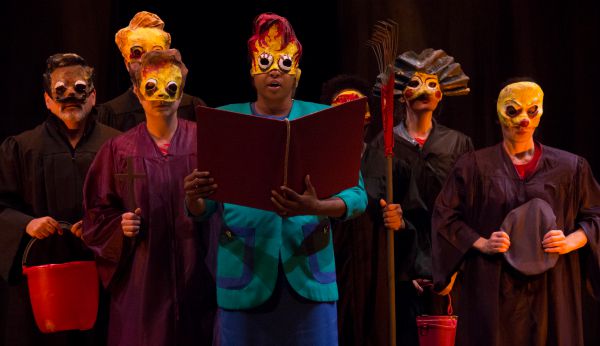“Mr Burns A Post-Electric Play” A Long Night

As the Bart Simpson and Mr Burns characters sang what felt like a nearly endless string of songs about dying in the third act of “Mr Burns a post-electric play,” I gazed at my watch. My God, man, just die, so this long, long series of songs can finally end, and we can all go home.
New Century Theatre’s most recent production of Anne Washburn’s dark comedy is a long theater experience– about two hours 40 minutes, including two ten-minute intermissions. It was not the fault of the actors that I felt restless. It was the play’s ponderous second act, musical numbers that seemed to me to drag on too long, and a general confusion about what the point of all of this was. I’m not alone–when this show opened in New York, some critics also felt that what the subject could have been summed up in a tidy two acts, instead of three.
The play is set in the near future–the bad future, where calamity has hit, people are talking about the terrible things that are going on in Boston. “It’s bad up there,” says Gibson (Paul Melendy) ominously, and there are scary people knocking at the door, and there are guns. But what the actors keep talking about is a long-lost episode of the popular cartoon TV show, The Simpsons. We’ve all been there–you recount what you remember about a certain episode, and people chime in, contributing to the group’s collective memory of the episode. It’s ok for a while–but what if you did this for fifteen minutes? Ok, Ok, enough. Like the dying that couldn’t happen fast enough, this is pretty thin gruel for an entire first act, especially when there is a post apocalyptic world out there to worry about. But maybe in this bleak world, memories of The Simpson’s episodes are better than facing more bad news like what happened to the people whose names are recorded in the notebooks. Scary, for sure. So when a stranger, Gibson, appears, the guns are drawn. It turns out he actually knows what happened to Sideshow Bob in that same damn Simpson’s episode! Cue the music!
I”m a pretty big fan of The Simpsons, but in a 22-minute cartoon, you can quickly cut in funny scenes like a Gilbert and Sullivan salute, and in just seconds, capture the point. In live theater, it just drags on, and the audience is left simply wondering why it is taking so long. Most of the show’s laughs came directly from The Simpson’s scripts–clever banter between Bart and Mr Burns, or riffs on popular movies like Cape Fear. The one character who got the most laughs was Gibson, (Paul Melendy), who later shows off a talented singing voice in the third act. In the second act, he shouts out randomly, “call the plumber!”, and his nervous ticks and accents got more laughs than anything else.
I wondered what the many seniors in the audience who most likely, haven’t ever seen a Simpsons episode, were thinking. As this play is billed as a dark comedy, it wandered into a grey area–what means what, and how would anyone know? I found myself parsing the song lyrics in the all-musical third act, trying to piece together what had happened to the world. Washburn’s idea of a post-apocalyptic play set in ‘the near future’ and then having a second act seven years later, and a third that’s even 75 years later is clever. But oblique hints are not satisfying, and the lyrics didn’t reveal more than ‘we don’t talk about that stuff.’
The second act is actually a play within the play, and we see actors reading lines along with the other actors slightly off stage mouthing the same dialogue, a funny kind of close-up into the actor’s world. Quincy, (Stephanie Carlson) evokes grimaces from her fellow actors as insults a female actor, and talks about arcane details that were confusing..about how they buy lines from people in a mysterious place called “The booth;” about a rival acting company called “Richards” who seem to be attracting larger audiences. But this confusing shop talk is interrupted by a sudden urge to sing, and then we are given a rendition of a string of familiar disco hits mixed with the more familiar strains of the Simpson’s theme song. Confused? I sure was.
By the time we got to the third act, which was all music, it was time for musical director Mitch Chakour to do his thing. He helped punctuate the actor’s lines with his piano notes, and his three piece band was tight. In this act everyone donned clay masks pictured above, looking a little like their Simpson’s characters, with the famous Itchy and Scratchy, (the violent cartoons inside every Simpson’s episode) representing the dark forces of evil people who, despite the frivolity on stage, still lurked out there in this very dark 75-years-ahead future.
This is indeed a dark comedy–maybe it’s like Mass MOCA, where I never understand any of the art. It’s entertaining for sure, and the actors do their best to muddle through this thicket of a script. It’s hard to pick out individual performances because of the nature of the the characters–I didn’t like any of them, felt no emotion about them because honestly, it wasn’t obvious to me what any of them felt about life after the apocalypse. And that’s a question much more interesting than what happened in that Simpsons episode.
Mr Burns a post-electric play, New Century Theatre, Mendenhall Center for the Performing Arts at Smith College, through Sunday August 8. Tickets www.newcenturytheatre.org.
